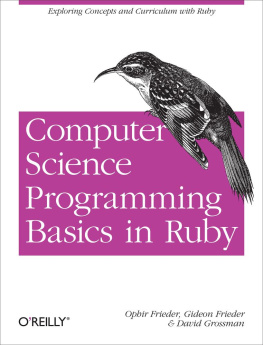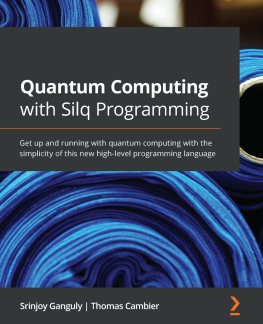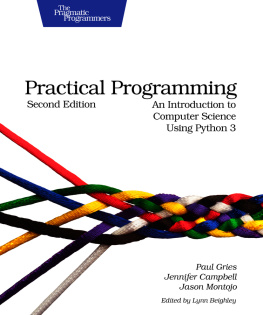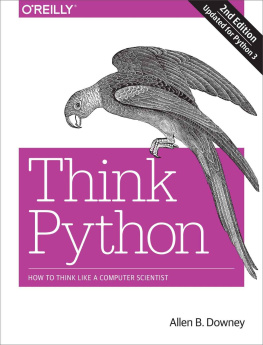Computer Science Programming Basics with Ruby
Ophir Frieder
Gideon Frieder
David Grossman
Preface
Computer science introductory texts are often unnecessarily long. Many exceed 500 pages, laboriously describing every nuance of whatever programming language they are using to introduce the concepts.
There is a better way: a programming language that has a low entry barrier. Preferably, the language selected should be a real, widely used language with a subset that is powerful and useful, yet mercifully small. Such a choice should arm the readers with marketable tools. The esoteric details of the programming language, however, should be ignored but with pointers for future investigation provided.
Ruby is a programming language well suited to this task. It is object-oriented, interpreted, and relatively straightforward. More so, instead of being purely educationally oriented, its popularity in industry is steadfastly growing.
Our book should be covered in sequential fashion. Each chapter assumes that the material from the preceding chapters has been mastered. To focus the discussion, we ignore gory details, such as user interface design and development issues, that we believe are ancillary to the core of computer science. Such issues should be, and are, covered in depth in a variety of subsequent courses.
Our target audience is students and practitioners who wish to learn computer science using Ruby rather than just how to program in a given language. This book consistently emphasizes why computer science is different from computer programming. Students and practitioners must understand what an algorithm is and what differentiates differing algorithms for the same task. Although we are living in an era of growing computational resources, we are also living in a world of growing data sets. Data amass every day; thus, efficient algorithms are needed to process these data.
Students and practitioners completing a course using this book possess foundational knowledge in the basics of computer science and are prepared to master abstract and advanced concepts. Second semester courses should rely on languages other than Ruby, furthering the understanding that programming languages are just interchangeable, expressive tools. We know, however, that many students and practitioners may not take another computer science course. If that is the case, this book provides them with an overview of the field and an understanding of at least one popular programming language that happens to be useful from both a practical and a pedagogical standpoint.
Concepts taught in this book provide students and practitioners with a sufficient foundation to later learn more complex algorithms, advanced data structures, and new programming languages.
Finally, we hope to instill a core appreciation for algorithms and problem solving so students and practitioners will solve problems with elegance and inspiration rather than simply plowing ahead with brute force.
The slides corresponding to this book and the source code listed in the book are available at http://ir.cs.georgetown.edu/Computer_Science_Programming_Basics_with_Ruby.
Conventions Used in This Book
The following typographical conventions are used in this book:
ItalicIndicates new terms, URLs, email addresses, filenames, and file extensions
Constant widthUsed for program listings, as well as within paragraphs to refer to program elements such as variable or function names, databases, data types, environment variables, statements, and keywords
Constant width boldShows commands or other text that should be typed literally by the user
Constant width italicShows text that should be replaced with user-supplied values or by values determined by context
Tip
This icon signifies a tip, suggestion, or general note
Using Code Examples
This book is here to help you get your job done. In general, you may use the code in your programs and documentation. You do not need to contact us for permission unless youre reproducing a significant portion of the code. For example, writing a program that uses several chunks of code from this book does not require permission. Selling or distributing a CD-ROM of examples from OReilly books does require permission. Answering a question by citing this book and quoting example code does not require permission. Incorporating a significant amount of example code from this book into your products documentation does require permission.
We appreciate, but do not require, attribution. An attribution usually includes the title, author, publisher, and ISBN. For example: Computer Science Programming Basics in Ruby by Ophir Frieder, Gideon Frieder, and David Grossman (OReilly). Copyright 2013 Ophir Frieder, Gideon Frieder, and David Grossman, 978-1-449-35597-5.
If you feel your use of code examples falls outside fair use or the permission given here, feel free to contact us at .
Safari Books Online
Note
Safari Books Online (www.safaribooksonline.com) is an on-demand digital library that delivers expert content in both book and video form from the worlds leading authors in technology and business.
Technology professionals, software developers, web designers, and business and creative professionals use Safari Books Online as their primary resource for research, problem solving, learning, and certification training.
Safari Books Online offers a range of product mixes and pricing programs for organizations, government agencies, and individuals. Subscribers have access to thousands of books, training videos, and prepublication manuscripts in one fully searchable database from publishers like OReilly Media, Prentice Hall Professional, Addison-Wesley Professional, Microsoft Press, Sams, Que, Peachpit Press, Focal Press, Cisco Press, John Wiley & Sons, Syngress, Morgan Kaufmann, IBM Redbooks, Packt, Adobe Press, FT Press, Apress, Manning, New Riders, McGraw-Hill, Jones & Bartlett, Course Technology, and dozens more. For more information about Safari Books Online, please visit us online.
How to Contact Us
Please address comments and questions concerning this book to the publisher:
| OReilly Media, Inc. |
| 1005 Gravenstein Highway North |
| Sebastopol, CA 95472 |
| 800-998-9938 (in the United States or Canada) |
| 707-829-0515 (international or local) |
| 707-829-0104 (fax) |
We have a web page for this book, where we list errata, examples, and any additional information. You can access this page at http://oreil.ly/comp_sci_basics_ruby.
To comment or ask technical questions about this book, send email to .
For more information about our books, courses, conferences, and news, see our website at http://www.oreilly.com.
Find us on Facebook: http://facebook.com/oreilly
Follow us on Twitter: http://twitter.com/oreillymedia
Watch us on YouTube: http://www.youtube.com/oreillymedia
Acknowledgments
Gone are the days where one needs to set the stage with computers are everywhere or computers are a commodity. Clearly, computers are everywhere, are used by everyone, and permeate every daily function and activity. Unfortunately, the majority of society can only use ready-made computer applications; they cannot program computers. With this book, we intend to change that!
In authoring this book, a five-year process, we benefited from and are grateful for the help of many; here we name but a few and apologize to those whose help we inadvertently forgot to acknowledge by name.











